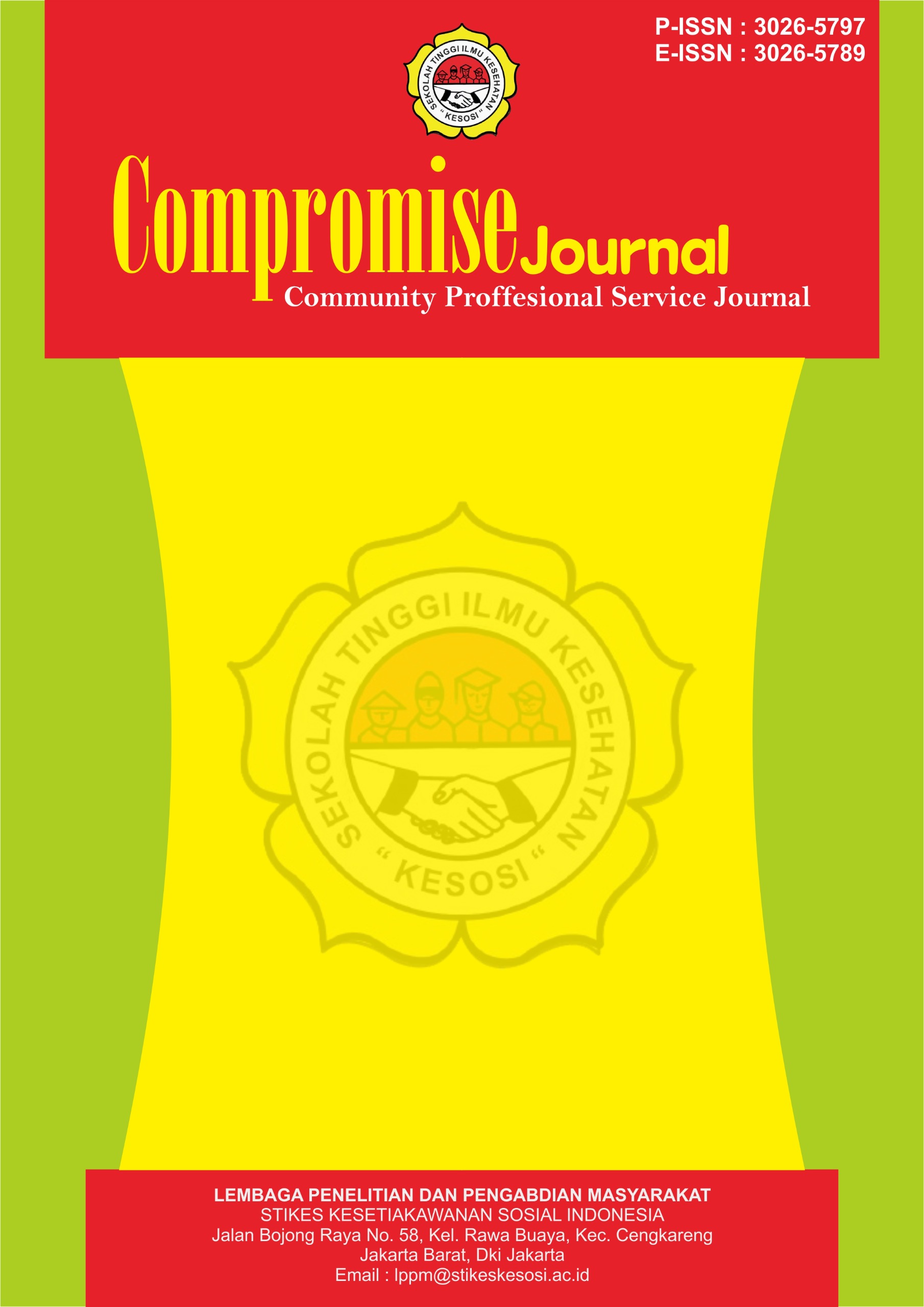Kesadaran Fertilitas pada Penyedia Layanan Kesehatan di Puskesmas Tambora, Jakarta Barat
DOI:
https://doi.org/10.57213/compromisejournal.v2i3.410Keywords:
Fertility Awareness , Fertility Decline, Health Service Providers, Tambora Health CenterAbstract
Objective: To determine the level of awareness of health workers towards fertility at Tambora Health Center, especially regarding age-related fertility decline. Methods: A survey was conducted on health workers at Tambora Health Center, West Jakarta on May 18, 2024. Participants were given a questionnaire regarding their perceptions and knowledge of fertility issues consisting of seven questions. The instrument has shown good validity, reliability, and consistency with Cronbach's alpha > 0.7. Descriptive analysis was used to describe the data using SPSS. Results: The majority of respondents believed that the most fertile age is 26-28 years (53%). Most respondents believed that there is a slight decline in a woman's ability to conceive at the age of 36-45 years (75%). Twenty-five percent of respondents stated that the chances of success for infertile couples undergoing IVF are 40-100%. Conclusion: Despite rapid progress in the development of fertility in clinical practice, this study shows that awareness of fertility is still low among health workers. There is a need for increased education for health care providers regarding fertility knowledge.
References
Alfaraj, S., Aleraij, S., Morad, S., Alomar, N., Rajih, H. A., Alhussain, H., & et al. (2019). Fertility awareness, intentions concerning childbearing, and attitudes toward parenthood among female health professions students in Saudi Arabia. International Journal of Health Sciences, 13(3), 34. https://www.ncbi.nlm.nih.gov/pmc/articles/PMC6512144/
American College of Obstetricians and Gynecologists. (2024). Female age-related fertility decline. https://www.acog.org/clinical/clinical-guidance/committee-opinion/articles/2014/03/female-age-related-fertility-decline
Anspach Will, E., Maslow, B. S., Kaye, L., & Nulsen, J. (2017). Increasing awareness of age-related fertility and elective fertility preservation among medical students and house staff: A pre- and post-intervention analysis. Fertility and Sterility, 107(5), 1200-1205.e1. http://www.fertstert.org/article/S0015028217302510/fulltext
Centers for Disease Control and Prevention. (2024). What is infertility? https://www.cdc.gov/reproductivehealth/features/what-is-infertility/index.html
de Guzman, G. S., Manalo, E. M., & Banal-Silao, M. J. B. (2023). Awareness and perceptions of Filipino obstetrician-gynecologists on fertility preservation: A cross-sectional survey. BMC Women's Health, 23(1). https://pubmed.ncbi.nlm.nih.gov/37231501/
Dewi, A. K., Wicaksana, A. L., Lutfi, M., & Dewanto, A. (2023). The barriers of joining in vitro fertilization programs among infertile couples in developing countries: A scoping review. Asian Pacific Journal of Reproduction, 12(4), 147-154. https://journals.lww.com/apjr/fulltext/2023/12040/the_barriers_of_joining_in_vitro_fertilization.1.aspx
Direktorat Jenderal Pelayanan Kesehatan. (2024). Kemandulan: Infertil, stigma negatif pada wanita Indonesia. https://yankes.kemkes.go.id/view_artikel/12/kemandulan-infertil-stigma-negatif-pada-wanita-indonesia
Dundar Akın, O., Boza, A., Yakin, K., & Urman, B. (2019). Awareness of fertility and reproductive aging in women seeking oocyte cryopreservation, reproductive aged controls, and female health care professionals: A comparative study. European Journal of Obstetrics & Gynecology and Reproductive Biology, 233, 146-150. https://pubmed.ncbi.nlm.nih.gov/30597339/
Hickman, L. C., Fortin, C., Goodman, L., Liu, X., & Flyckt, R. (2018). Fertility and fertility preservation: Knowledge, awareness and attitudes of female graduate students. The European Journal of Contraception & Reproductive Health Care, 23(2), 130-138. https://www.tandfonline.com/doi/abs/10.1080/13625187.2018.1455085
Hoffman, M. B., Schorge, J. O., Halvorson, L. M., Hamid, C. A., Corton, M. M., & Schaffer, J. I. (2020). Williams gynecology (4th ed.). McGraw-Hill Professional.
Li Piani, L., Vigano, P., & Somigliana, E. (2023). Epigenetic clocks and female fertility timeline: A new approach to an old issue? Frontiers in Cell and Developmental Biology, 11. https://www.ncbi.nlm.nih.gov/pmc/articles/PMC10070683/
MSD Manual. (2024). Overview of infertility - Women’s health issues. https://www.msdmanuals.com/home/women-s-health-issues/infertility-and-recurrent-miscarriage/overview-of-infertility/?autoredirectid=23332
Ng, E. Y. L., Ip, J. K. H., Mak, D. R., Chan, A. Y. W., & Chung, J. P. W. (2020). Awareness of fertility preservation among Chinese medical students. Hong Kong Medical Journal, 26(3), 184-191. https://pubmed.ncbi.nlm.nih.gov/32482910/
Ombelet, W. (2011). Global access to infertility care in developing countries: A case of human rights, equity and social justice. Facts, Views & Vision in ObGyn, 3(4), 257. https://www.ncbi.nlm.nih.gov/pmc/articles/PMC3987469/
Place, J. M., Peterson, B. D., Horton, B., & Sanchez, M. (2022). Fertility awareness and parenting intentions among Mexican undergraduate and graduate university students. Human Fertility, 25(2), 397–406. https://pubmed.ncbi.nlm.nih.gov/32896180/
Ren, Y., Xie, Y., Xu, Q., Long, M., Zheng, Y., Li, L., & et al. (2023). University students’ fertility awareness and its influencing factors: A systematic review. Reproductive Health, 20(1), 1-12. https://reproductive-health-journal.biomedcentral.com/articles/10.1186/s12978-023-01628-6
Rouchou, B. (2013). Consequences of infertility in developing countries. Journal of International Women’s Studies, 13(3), 174-179. https://journals.sagepub.com/doi/10.1177/1757913912472415
Vander Borght, M., & Wyns, C. (2018). Fertility and infertility: Definition and epidemiology. Clinical Biochemistry, 62, 2-10.
Wiersema, N. J., Drukker, A. J., Dung, M. B. T., Nhu, G. H., Nhu, N. T., & Lambalk, C. B. (2006). Consequences of infertility in developing countries: Results of a questionnaire and interview survey in the South of Vietnam. Journal of Translational Medicine, 4(1), 1-8. https://translational-medicine.biomedcentral.com/articles/10.1186/1479-5876-4-54
World Health Organization. (2023). 1 in 6 people globally affected by infertility. https://www.who.int/news/item/04-04-2023-1-in-6-people-globally-affected-by-infertility
World Health Organization. (2023). Infertility prevalence estimates 1990-2021. https://www.who.int/publications/i/item/978920068315
World Health Organization. (2024). Infertility. https://www.who.int/news-room/fact-sheets/detail/infertility
Yu, L., Peterson, B., Inhorn, M. C., Boehm, J. K., & Patrizio, P. (2015). Knowledge, attitudes, and intentions toward fertility awareness and oocyte cryopreservation among obstetrics and gynecology resident physicians. Marriage and Family Therapy Faculty Articles and Research, 31(2), 403-411. https://digitalcommons.chapman.edu/mft_articles/6
Zegers-Hochschild, F., Adamson, G. D., Dyer, S., Racowsky, C., De Mouzon, J., Sokol, R., & et al. (2017). The International Glossary on Infertility and Fertility Care, 2017. Human Reproduction, 32(9), 1786-1801. https://pubmed.ncbi.nlm.nih.gov/29117321/
Downloads
Published
Issue
Section
License
Copyright (c) 2024 Compromise Journal : Community Proffesional Service Journal

This work is licensed under a Creative Commons Attribution-ShareAlike 4.0 International License.






